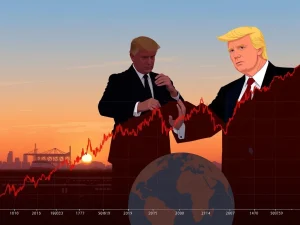Goldman Sachs CEO Reveals Unlikely 50 Basis Point Fed Rate Cut Scenario

The financial world keenly watches every pronouncement from major institutions, especially regarding the future of interest rates. Recently, Goldman Sachs CEO David Solomon shared his critical perspective on the likelihood of significant Fed rate cuts. His comments have quickly resonated across global markets, influencing expectations and discussions among investors. This article explores Solomon’s views, the broader interest rate outlook, and the potential crypto market impact, offering crucial insights for those navigating today’s complex economic landscape.
Goldman Sachs CEO Casts Doubt on Aggressive Rate Cuts
David Solomon, the prominent Goldman Sachs CEO, recently expressed skepticism regarding the prospect of a substantial 50 basis point interest rate cut by the US Federal Reserve in September. Solomon believes such an aggressive move is “probably not on the cards.” This statement comes just days after Standard Chartered Bank made an unexpected forecast for a larger reduction. His remarks provide a clear counter-narrative to some of the more bullish predictions circulating in financial circles. Solomon’s seasoned perspective often offers a grounding influence on market sentiment, guiding investor expectations.
Market participants largely align with Solomon’s cautious stance. Data from the CME FedWatch Tool indicates that only 7.8% of market observers anticipate a 50 basis point cut at the September 17 Fed meeting. A vast majority, 92.2%, expect a more modest 25 basis point reduction. Solomon himself confidently stated, “I’m pretty confident we’ll have a 25 basis rate cut.” This consensus suggests a general understanding of the Fed’s measured approach to monetary policy adjustments. Investors, therefore, adjust their strategies accordingly, favoring a more gradual easing.
The Broader Interest Rate Outlook and Market Divergence
While Solomon dismisses a 50 basis point reduction, he does foresee additional Fed rate cuts later this year. He anticipates one or two more cuts, depending on how economic conditions evolve. This aligns with a general trend among financial institutions revising their forecasts. For instance, analysts at Bank of America recently reversed their long-held position of no rate cuts in 2025. They now project two 25 basis point cuts: one in September and another in December. These shifts highlight the dynamic nature of economic predictions.
Standard Chartered Bank’s aggressive forecast for a 50 basis point cut stemmed from August’s weaker-than-expected jobs report. This data point fueled speculation that the Fed might act more decisively to stimulate the economy. However, most experts, including David Solomon, suggest the Fed will likely maintain a more conservative path. Fed Chair Jerome Powell also signaled a potential September rate cut during his keynote speech at the Jackson Hole Economic Symposium on August 22, yet he did not specify the magnitude, allowing for various interpretations.
Labor Market Softening Influences Fed Rate Cuts
A key factor influencing the Federal Reserve’s decisions on Fed rate cuts is the state of the labor market. David Solomon specifically highlighted this aspect. “There’s no question that when you look at the labor market, there’s a little bit of a softening,” he observed. A softening labor market, characterized by slower job growth or rising unemployment, often signals a need for monetary easing to support economic activity. The Fed typically aims for a ‘soft landing,’ where inflation cools without triggering a severe recession.
The interplay between inflation, employment, and interest rates forms the core of the Fed’s mandate. When the labor market shows signs of weakness, it can justify rate reductions. However, the Fed must balance this against inflation concerns. A gradual approach to rate cuts allows the central bank to assess incoming economic data meticulously. This cautious strategy helps prevent overshooting or undershooting the desired economic conditions, ensuring stability.
Understanding the Crypto Market Impact of Rate Decisions
The decisions surrounding Fed rate cuts hold significant implications for the crypto market impact. Generally, lower interest rates make traditional investments, such as bonds, less attractive. This often encourages investors to seek higher returns in riskier, yet potentially more rewarding, assets like cryptocurrencies. Consequently, the prospect of rate cuts frequently sparks bullish sentiment within the crypto community. Many traders closely monitor Fed announcements, anticipating market movements.
For instance, crypto trader Mister Crypto commented on X, stating, “If that happens, crypto will explode through previous ATHs,” referring to a hypothetical 50 basis point cut. Bitcoin has already shown sensitivity to economic data, breaking $114K following cooling US PPI data, which boosted rate cut bets. However, the sentiment platform Santiment recently issued a warning. They noted a surge in social media chatter around the highly anticipated September interest rate decision. Historically, such massive spikes in discussion around a single bullish narrative can indicate that euphoria is getting too high, potentially signaling a local top for the market.
Navigating the Evolving Interest Rate Outlook
The current interest rate outlook remains a critical discussion point for investors globally. While a 50 basis point cut seems improbable, the consensus points towards a 25 basis point reduction, with potentially more to follow. David Solomon‘s measured comments reflect a broader cautious approach among leading financial institutions. This measured pace allows the Fed to respond to economic data without causing undue market volatility. Understanding these nuances is essential for making informed investment decisions.
Investors should continue to monitor official Fed communications, economic reports, and the insights from figures like the Goldman Sachs CEO. The relationship between macroeconomic policy and the crypto market impact is undeniable. As the year progresses, the unfolding economic conditions will dictate the precise timing and magnitude of future rate adjustments. Staying informed and adaptable remains key for participants in both traditional and digital asset markets.







